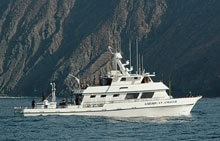
|| |—| || |STRIKING OUT: San Diego long-range boats travel from 300 to 1,600 miles to reach fishing grounds. Trips range from three- to five-day jaunts to 15- to 18-day adventures. Photo: Chuck Garrison| It was a tossup as to which creature, facing off at opposite ends of the rod, was sagging more quickly. At one end, the anglerlegs wobbly, body slouched, lungs heaving and face covered in sweatwas reduced to resting the rod on the rail. At the other, the tunatail beating rhythmicallywas swimming, inch by inch, into tighter circles and closer to ga¿¿ng range. Its blimp-shaped body was now nearly flat on its side, signaling that the huge yellowfin had exhausted its reserves.
A gaff flashed, then two more. Three deckhands aboard the 124-foot Excel, out of Fisherman’s Landing in San Diego, lifted hand-over-hand, hoisting 210 pounds of glistening yellowfin tuna from the water, thudding its bulk on the deck. Elsewhere onboard, other battles raged, two beginning only moments before with cries of “Fresh one!” The shouts came often, as they usually do on long-range fishing odysseys.
On some trips, anglers release dozens of tuna between 150 and 200 pounds. On the Excel, a 13-day trip produced a single-boat best: 78 cows weighing more than 200 pounds each. (The season’s largest yellowfin tuna at this writing was a 323-pounder caught from the Shogun.)
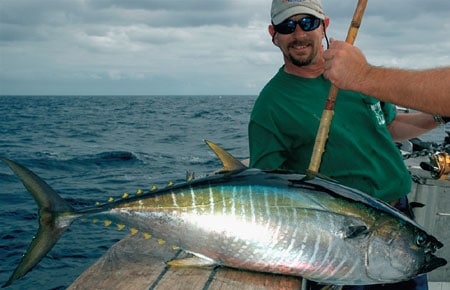
BOXING MATCH: Ten-day long-range trips target tuna in the 40- to 100-pound range.
Photo: Chuck Garrison
When a San Diego reporter asked Bill Poole, the Excel’s owner and a pioneering captain of long-range fishing, to describe the bounty of fishing in the “good ol’ days,” Poole was quick to reply. “These are the good ol’ days,” he said. “It doesn’t get any better than turning 150-pounders loose.”
To some anglers who would like to, but haven’t yet experienced one of those storied long-range fishing trips out of San Diego, the thought of such an undertaking might be daunting. There’s a new format to the fishing day, some new tackle to buy and new fishing techniques to master. As exciting, rewarding and unforgettable as a long-range trip can be, it can also be a foray out of an angler’s comfort zone.
Yet each year, new fishermen enter the long-range arena. Some are able to make the transition smoothly from single-day to extended-trip fishing. These are the anglers who learn that long-ranging doesn’t need to be a daunting task, and through planning and preparation, learn how to survive their first long-range trip.
The Lure of Distant Waters
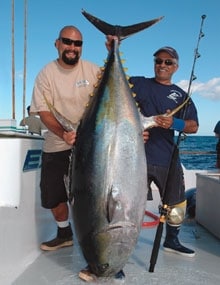
| |YELLOW STREAK: This huge yellowfin was just one of many taken aboard the Excel on a recent 10-day trip. Photo: Chuck Garrison| Beginning in the very early 1950s, Southern California sportfishing innovators, such as Poole, Otto Kiessig and Lee Palm, turned an eye southward from San Diego, intrigued by Mexico’s fish-rich waters. Off the Pacific coast of Baja California, at places like Guadalupe, San Benitos and the Cedros Islands, virtually untapped resources of yellowtail, giant black seabass, white seabass, grouper, bluefin and yellowfin tuna, calico bass, dolphin and other small to medium-size gamefish finned in abundance. Early vessels like Kiessig’s Sportfisher III, Poole’s Polaris and Palm’s Sportfisher IV plied the waters to the then-outer limits of the emerging long-range grounds and discovered a new form of fishing.
Over the past six decades, multi-day or so-called “long-range” fishing trips have pushed farther and farther south along and off the Baja peninsula, exploring such now-familiar sites as San Pablo Bay, Uncle Sam Bank, Alijos Rocks, the Potato, Thetis and Lusitania banks and the famed Revillagigedos. (Known for yellowfin nearing 400 pounds, the entire Revillagigedo archipelago, including the waters around Clarion, San Benedicto and Socorro Islands, plus Roca Partida, is now closed to all types of fishing by the government of Mexico.)
Long-range schedules, which once included destinations some 300 miles distant, gradually extended to haunts 500, 700, then close to 1,000 miles southand farther. Today, trips reach as far south as Hurricane Bank. In the past, a few 23-day expeditions ventured about 1,600 miles to French-owned Clipperton Island.
As the fleet pushed steadily southward, with larger, safer, more comfortable boats, fish holds went from storing yellowtail, calico bass, albacore and giant seabass to adding more exotics like dolphin, wahoo, yellowfin and the occasional rainbow runner. The fledgling San Diego-based fleet of two or three, narrow-beamed boats in the 65-foot class has grown to a dozen deluxe vessels that range from 88 to 124 feet long and up to 32 feet wide and feature amenities like stateroom berthing, air conditioning, plasma-screen TVs, gourmet meals and multi-ton fish holds.
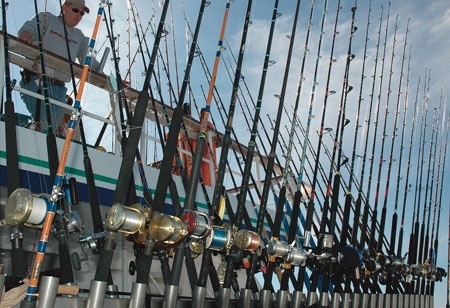
Specialized gear is ready to go.
Photo: Chuck Garrison
Range Finder
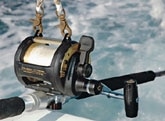
| |
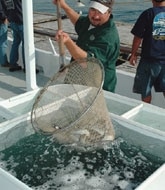
| |LONG-RANGE ROCKETS: (top) Anglers secure trolling outfits to the rail with quick-release snaps. (bottom) Load up on live bait. Photo: Chuck Garrison| While some operators offer 1 1/2- to three-day trips during the albacore season, these runs aren’t considered by most anglers to be traditional long-range trips. These shorter schedules focus almost exclusively on catching the long-finned tuna, while long-range trips offer more fishing days for a variety of species.
In simplest terms and broadest categories, long-range trips and their targeted species include the following:
Four- to Five-Day Trips: yellowtail, calico bass, barracuda, bonito, rockfish, whitefish, possibly white seabass (spring) and albacore (summer, en route to and returning from principal destination)
Six- to Eight-Day Trips: yellowtail, yellowfin tuna (mostly 12- to 100-pounders), calico bass, grouper, giant seabass (usually released), dolphin and possibly some chances at wahoo (in warm-water cycles)
Ten-Day Trips: yellowtail, larger yellowfin (many in the 40- to 150-pound range), wahoo, kelp-paddy dolphin and incidental catches of calico bass and whitefish
16-Day (or longer) Trips: Many of these offer fly-back options from Cabo San Lucas, Mexico. Trips principally target giant yellowfin tuna and 30- to 80-pound wahoo. Stopovers en route to fishing grounds produce yellowtail or dolphin from kelp paddies.
To experience a true long-range fishing trip, instead of just a two- or three-day jaunt offshore for albacore, a newcomer to the sport may find a six- to eight-day trip to be an ideal introduction. Given a good catch, a six- or seven-day trip can yield plenty of hot action for yellowtail weighing more than 50 pounds, some excellent calico bass fishing, albacore (in season) between the main fishing grounds, occasional flurries of spring white seabass and a chance for smaller-size, 15- to 50-pound, yellowfin tuna and ten- to 25-pound dolphin during warm-water periods. On eight-day trips the faster boats head more than 500 miles south, offering a chance for exciting catches of wahoo and larger yellowfin pushing or exceeding 100 pounds.
Some first-time long rangers jump in and immerse themselves in a ten-to-16- or 18-day trip. But they had better be quick studies and hold tightly to a meteoric learning curve to adapt successfully to the giant fish and specialized gear and methods required. If you want the advantages and mainstream species of a six- to eight-day trip, a fair to good chance at catching a few wahoo and greater numbers of 40- to 150-pound yellowfin tuna, it’s best to go for a ten-day long-range trek.
Battle Gear
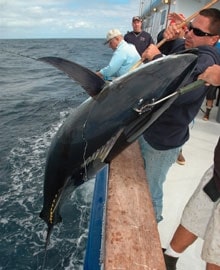
| |RIDING THE RAILS: A big yellowfin is muscled aboard. This two-gaffer might seem huge to many, but 2005 saw a new long-ranger record for 200- to 300-pound tuna. Photo: Chuck Garrison| It’s critical to step aboard a long ranger with the proper gear. But what tackle should you take on a trip that lasts several days and targets fish in more abundance and larger sizes than those found in U.S. waters?
For catching small to medium-size gamefish, the same tackle used to catch yellowtail off Southern California, red drum in the Gulf or stripers off the East Coast works fine. For the longer trips, which typically include record-class yellowfin tuna or razor-toothed wahoo, special gear is needed, including high-leverage rods equipped with all-roller guides; two-speed, twin-drag reels spooled with braided line and mono top shots; large rod-butt plates and low-back, butt fighting harnesses; wire-leader rigs; wahoo-casting “bombs” and more. And to assemble some of the rigs, learn to tie specialty knots, such as the Trilene knot and Bimini twist.
There are several ways to get tackle savvy and rigging proficient. First, if you live in or around Southern California, you can attend one of the two major Fred Hall Fishing Tackle and Boat Shows (www.fredhall.com) held every March. The larger of the two events—at the Long Beach Convention Center in Long Beach—is co-hosted by the American Sportfishing Association and is the largest consumer fishing-tackle show in the country, if not the world. The Hall shows (the second largest is held at the Del Mar Fairgrounds in San Diego County, just a few miles from the home port of the long-range fleet) are chock-full of salt water tackle, much of which is designed for the long-range angler.
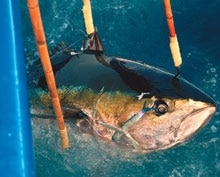
| |ALL ABOARD: Gaffers are experienced in hoisting tuna over the rails. Photo: Chuck Garrison| A bonus to attending the shows is that each of the five-day events includes a series of fishing seminars and demonstrations about long-range tackle and techniques, many conducted by skippers who operate these long-range trips.
Nowadays, virtually all operators offer special tackle packages, ranging from three to five or more rod-and-reel combos. Depending on the type of trip involved, tackle is either offered on a break-even, wear-and-tear-only cost basis or, in the case of some operators, provided for free. The rods and reels making up these rental or complimentary sets are rugged, high-quality equipment.
Toughen Up
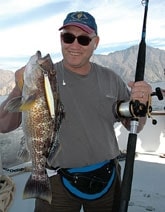
| |FIGHT LIKE A MAN: Cabrilla are caught on trips for smaller inshore species. Photo: Chuck Garrison| A smart long-range angler loses pounds and gains muscle before taking one of these trips. The shorter, four-to-seven- or even eight-day trips aren’t so physically or mentally demandingpulling against several yellowtail, albacore, dolphin or smaller yellowfin tunabut remember this: the fishing is often literally from sunrise to sundown and you may see that situation for days in a row. After following many fish up and down the deck, around the anchor, in and out of tangles, plus untold trips to and from the bait tank, tackle box and rod racks, will wear you down.
And that’s just a warm-up. Take one of the longer, giant tuna trips where battling some 150- to 300-pound blimps quickly turns into a standup, slug-it-out, back-alley, John Wayne brawl. Since there are no fighting chairs on these vessels, large-framed men are sometimes brought literally to their knees during these grueling enduros. Having fun yet?
To maximize your experience, get yourself in shape before the trip. The better your physical condition, the more enjoyable your trip will be and the more successful your fishing efforts. And if you think these words are overdramatized, consider ordering one or two long-range fishing videos or DVDs produced by Oceanic Productions (www.fishingvideos.com) or Inside Sportfishing (www.insidesportfishing.com). They contain plenty of exciting footage and some excellent instruction.
Be preparedboth physically and mentallyfor battles with bruiser tuna that can last upwards of two hours.
If you go in knowing you will need to pace yourself and keep your head, you will be able to enjoy your voyage to a faraway fishing paradise.
| Go Long To book a long-range fishing excursion, contact the following sources.Fisherman’s Landing www.fishermanslanding.com (619) 221-8500Point Loma Sportfishing www.pointlomasportfishing.com (619) 223-1627Lee’s Palm’s Long-Range Sportfishing www.redrooster3.com (619) 224-3857H & M Landing www.hmlanding.com (619) 222-1144 |









